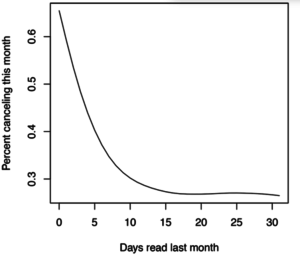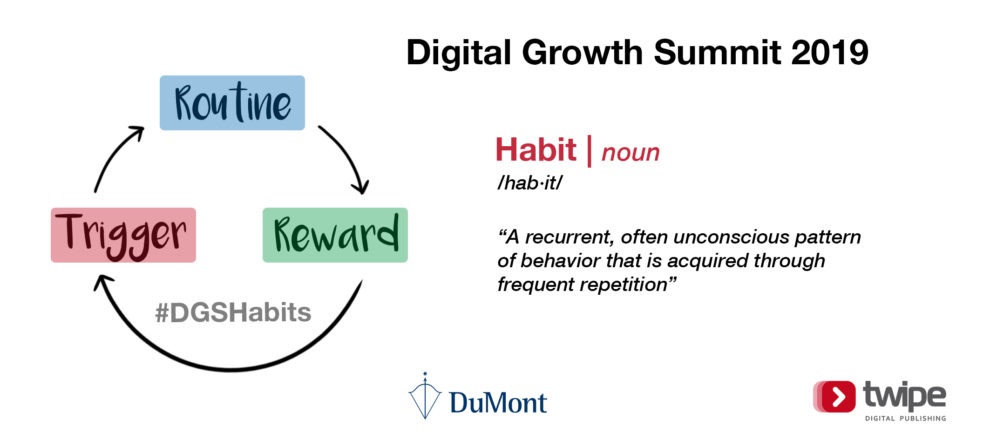Why habit formation is key for all news media
At Twipe we identified habit formation as the key theme to focus on in our research this year. In our latest article in our habits series, we explore the newest research on habit formation.
Earlier this year, the Medill Local News Initiative at Northwestern released research that confirmed a longstanding belief: habit formation is key for sustainable news products. Through analysis of subscriber data from large American titles, frequency emerged as the most important aspect for retention. With this focus on large titles though, smaller market news outlets were not sure if the findings were relevant for them as well. Now the same research has been run with 12 small news outlets from Gannett. Join us as we dig into this question of how all news publications can benefit from an increased focus on habit formation.
The importance of a daily habit
In this new analysis, the number of days a subscriber reads in a month was found to relate to the percent cancelling their subscription. In the chart below, we can see a sharp decline between subscribers reading 0 to 10 days a month — the cancellation rate is cut by more than half. Between 10 days to 30 days, the cancellation rate holds steady.

With this clear business impact, it’s clear why leading publishers are investing more in their engagement strategies than acquisition. Note however that engagement is key in the beginning of your relationships with a reader: a habit is formed in the first 100 days or not at all. So how can publishers work to develop reader habits? It’s a key question in the news media industry today, which is why we’re convening 150 leaders to discuss exactly this at our Digital Growth Summit. If this is a concern for you as well, apply now to join our discussion under the guidance of keynote speaker Nir Eyal, best selling author of “Hooked”.
In most habit formation strategies, there must first be a trigger which activates a routine than is then rewarded. This cycle becomes a habit loop, encouraging people to continue the action until it becomes a full habit. If you are interested in a deeper dive and practical applications of Eyal’s theory, read our complete guide to habit formation for news publishers.
Get your trigger right
As we know, a habit is created through triggers, either internally by a reader’s own desires or externally through an action taken by the publisher. Internal triggers can be activated though by a publisher’s actions if they understand their readers’ routines and what type of news they’re looking for during each part of their day. We’ve written extensively before about various other internal and external triggers, in this new study however they’ve focused on newsletters as a key trigger.
In France, Les Echos found that readers who came to their website via email are more loyal than those who came from social media or search. Readers are more and more commonly turning to their inboxes as a source of news as well, with a Reuters report finding that 25% of Americans choose email as a starting point to read the news. Newsletters are already a common strategy amongst many bigger titles, but lightly staffed outlets in smaller markets often can’t invest in this strategy as much. While they may not be able to have more than one or two newsletters, even an automatically created newsletter can serve as a daily trigger to read for subscribers.
Until recently, newsletters have mainly been customised (recipients opt-in to follow specific topics), rather than personalised (newsletters created for individual readers based on past behaviour). In this study, researchers proposed that hyper-personalised newsletters are vastly under-utilised, with the ability to become a paid subscription-only offering. The importance of this opportunity is something we identified with The Times and The Sunday Times back in 2017, which is why we launched “JAMES, Your Digital Butler“. This project was able to reduce churn 49% with the use of automated, personalised newsletters. Stay tuned as we will be releasing a report on this project shortly with more findings.
Reward your readers with what they need
To ensure readers truly adapt news into their daily routine, it’s important to provide a reward for reacting to the trigger. There are different ways to reward readers with the news content itself. In our own research at Twipe, we’ve defined the nine building blocks of positive effect. In this new research, three main aspects stand out.
Provide feeling of completion
Since we know it is frequency of reading news content and not the amount of time spent on any one day that matters most in retention, the feeling of completion becomes even more important. There’s been no shortage of hand wringing on the constant onslaught of information in today’s digital age and how more and more people are becoming “news avoiders” to cope. One of the key way to turn back this tide is by designing news products that are meant to be finished in a day, so that readers can step away from the news and return tomorrow — otherwise known as creating a daily habit for news consumption, rather than a constant but vague feeling of needing to read the news.
That’s why it is important to understand your most loyal readers may be those who only scan stories or spend a few minutes with your content but return day after day. To keep this habit, you’ll need to design your news experience with options for time crunched readers. For inspiration, The Economist’s Espresso and Le Monde’s Matinale du Monde stand out, which are featured in the first chapter of our Reinventing Digital Editions series. Both apps were developed to meet the needs of their busiest readers, and even managed to reach a new, younger audience at the same time.
Be useful
There’s a debate in the news media industry now, is the main goal of journalism to break news or explain it? In Europe it seems to be moving more and more towards explaining news while in the US there’s still what seems to be an obsession with breaking news. Either way, it was a bold decision in 2016 when The Times and The Sunday Times decided to no longer chase breaking news, but instead focus on providing the in-depth analysis their readers valued most.
One of the cases studied in the original research, The Chicago Tribune, took the learnings to heart and adapted their content strategy. The team realised their readers had different needs at different times, whether that be wanting more weather news in the winter or even down to what type of content is best suited to the morning versus the evening. For their readers, the morning is the best to time to highlight “things you need to know” while in the evening they can showcase “things that are nice to know”.
Offer differentiated content
Ultimately it is key to provide differentiated content, whether it be local news stories that no one else is reporting on or giving a different angle of a popular story. This is especially important for smaller markets, with research found that reading just one local story in a month cutting the cancellation rate in half. But this doesn’t mean only local stories matter; there’s still a strong demand for national news in smaller markets. This ties in with the finding from Reuters that even among people who will pay for online news, most will only pay for one subscription. Readers need both the local stories they can’t get anywhere else, along with the national stories that help provide insights and context for the wider world. Publishers are starting to act on this, switching away from “commodity news” to truly local news.
The evidence that audiences are unwilling to pay for local news is actually clouded by the fact that most local news is not local at all.
Rachel Davis Mersey, assistant professor at the Medill School
This article was written by Mary-Katharine Phillips, Media Innovation Analyst at Twipe from 2017 – 2021.
Other Blog Posts

Stay on top of the game
Join our community of industry leaders. Get insights, best practices, case studies, and access to our events.
"(Required)" indicates required fields


